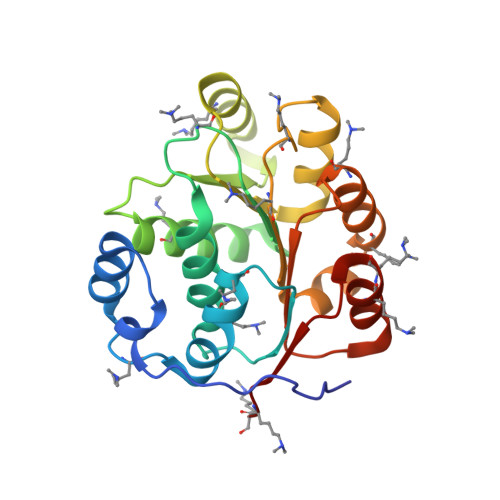Targeting the N Terminus of eIF4AI for Inhibition of Its Catalytic Recycling.
Jiang, C., Tang, Y., Ding, L., Tan, R., Li, X., Lu, J., Jiang, J., Cui, Z., Tang, Z., Li, W., Cao, Z., Schneider-Poetsch, T., Jiang, W., Luo, C., Ding, Y., Liu, J., Dang, Y.(2019) Cell Chem Biol 26: 1417-1426.e5
- PubMed: 31402318
- DOI: https://doi.org/10.1016/j.chembiol.2019.07.010
- Primary Citation of Related Structures:
5ZBZ - PubMed Abstract:
DEAD-box ATP-dependent helicases (DEAH/D) are a family of conserved genes predominantly involved in gene expression regulation and RNA processing. As its prototype, eIF4AI is an essential component of the protein translation initiation complex. Utilizing a screening system based on wild-type eIF4AI and its L243G mutant with a changed linker domain, we discovered an eIF4AI inhibitor, sanguinarine (SAN) and used it to study the catalytic mechanism of eIF4AI. Herein, we describe the crystal structure of the eIF4AI-inhibitor complex and demonstrate that the binding site displays certain specificity, which can provide the basis for drug design to target eIF4AI. We report that except for competitive inhibition SAN's possible mechanism of action involves interference with eIF4AI catalytic cycling process by hindering the formation of the closed conformation of eIF4AI. In addition, our results highlight a new targetable site on eIF4AI and confirm eIF4AI as a viable pharmacological target.
Organizational Affiliation:
Key Laboratory of Metabolism and Molecular Medicine, the Ministry of Education, Department of Biochemistry and Molecular Biology, School of Basic Medical Sciences, Fudan University, Shanghai 200032, China; Drug Discovery and Design Center, State Key Laboratory of Drug Research, Shanghai Institute of Materia Medica, Chinese Academy of Sciences, Shanghai 201203, China.

















